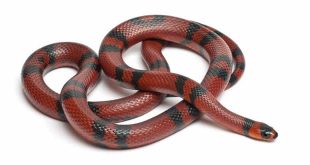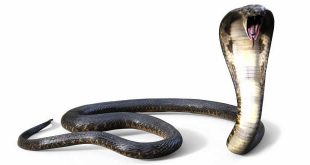 Sea Snake — Sea snakes, or “seasnakes”, are venomous elapid snakes which inhabit marine environments for most or all of their lives. Though they evolved from terrestrial ancestors, and some such as Laticauda sp. retain ancestral characteristics which allow limited movement on land, most are extensively adapted to a fully aquatic life and are unable to even move on land. They are found in warm coastal waters from the Indian Ocean to the Pacific. All have paddle-like tails and many have laterally compressed bodies that give them an eel-like appearance. However, unlike fish, they do not have gills and must come to the surface regularly to breathe. Nevertheless, they are among the most completely aquatic of all air-breathing vertebrates. Among this group are species with the most potent venoms of all snakes. Some have gentle dispositions and bite only when provoked, while others are much more aggressive. Currently, 17 genera are described as sea snakes, comprising 62 species.
Sea Snake — Sea snakes, or “seasnakes”, are venomous elapid snakes which inhabit marine environments for most or all of their lives. Though they evolved from terrestrial ancestors, and some such as Laticauda sp. retain ancestral characteristics which allow limited movement on land, most are extensively adapted to a fully aquatic life and are unable to even move on land. They are found in warm coastal waters from the Indian Ocean to the Pacific. All have paddle-like tails and many have laterally compressed bodies that give them an eel-like appearance. However, unlike fish, they do not have gills and must come to the surface regularly to breathe. Nevertheless, they are among the most completely aquatic of all air-breathing vertebrates. Among this group are species with the most potent venoms of all snakes. Some have gentle dispositions and bite only when provoked, while others are much more aggressive. Currently, 17 genera are described as sea snakes, comprising 62 species.
Adults of most species grow to between 120-150 cm (4-5 ft) in length, with the largest, Hydrophis spiralis, reaching a maximum of 3 m (10 ft). Their eyes are relatively small with a round pupil and most have nostrils that are located dorsally. The skulls do not differ significantly from other terrestrial elapids, although the dentition is relatively primitive with short fangs and, except in Emydocephalus, as many as 18 smaller teeth behind them on the maxilla.
Most sea snakes are completely aquatic and have adapted to their environment in many ways, the most characteristic of which is a paddle-like tail that has increased their swimming ability. To a varying degree, the bodies of many species are laterally compressed, especially in the pelagic species. This has often caused the ventral scales to become reduced in size, even difficult to distinguish from the adjoining scales. Their lack of ventral scales means that they have become virtually helpless on land, but since they live out their entire life cycle at sea, they never have any need to come out of the water.
The only species that have retained their enlarged ventral scales are the sea kraits, represented by the genus Laticauda, with only five species. This is considered to be a more primitive group, as they still spend much of their time on land where their ventral scales afford them the necessary grip. They are also the only sea snakes with internasal scales, i.e. their nostrils are not located dorsally.
As it is easier for a snake’s tongue to fulfill its olfactory function under water, its action is short compared to that of terrestrial snake species. Only the forked tips protrude from the mouth through a divided notch in the middle of the rostral scale. The nostrils have valves that consist of a specialized spongy tissue to keep water out, and the windpipe can be drawn up to where the short nasal passage opens into the roof of the mouth: an important adaptation for an animal that must still come to the surface to breathe air, but may have its head partially submerged when doing so. The lung has become very large and extends almost the entire length of the body, although it seems likely that the rear portion developed to aid buoyancy, rather than to exchange gas. The extended lung may also serve as a means of storing air for dives.
Sea snakes in general are able to respire through their skin. This is unusual for reptiles, because their skin is thick and scaly, but experiments with Pelamis have shown that this species can satisfy about 20% of its oxygen requirements in this manner, which allows for prolonged dives.
Like other land animals that have adapted to life in a marine environment, sea snakes ingest considerably more salt than their terrestrial relatives, through their diet and when sea water is inadvertently swallowed. This meant that they had to evolve a more effective means of regulating the salt concentration of their blood. Mammals have the advantage of being able to pass salt in solution, mostly in the urine, but kidney function in birds and reptiles is too weak to remove salt in sufficient amounts. In birds, such as penguins, salt is removed through nasal glands, just as with the marine iguanas of the Galapagos Islands. Sea turtles have lacrimal glands that allow them to produce very salty tears. But in sea snakes, the posterior sublingual glands, located under and around the tongue sheath, evolved to allow them to expel salt with their tongue action.
Scalation among sea snakes is highly variable. As opposed to terrestrial snakes, species that have imbricate scales to protect against abrasion, the scales of most pelagic sea snakes do not overlap. Reef dwelling species, such as Aypisurus, do have imbricate scales to protect against the sharp coral. The scales themselves may be smooth, keeled, spiny or granular, the latter often looking like warts. The black-and-yellow sea snake, Pelamis platurus, a pelagic species, has body scales that are “peg-like”, while those on its tail are juxtaposed hexagonal plates.
Aipysurus laevis has been found to have photoreceptors in the skin of its tail, allowing it to detect light and presumably aiding it in remaining hidden inside of coral holes during the day. While other species have not been tested, it is possible that A. laevis is not unique among sea snakes in this respect.
 Kids Portal For Parents India Kids Network
Kids Portal For Parents India Kids Network


